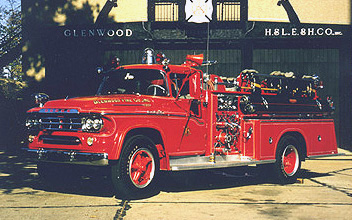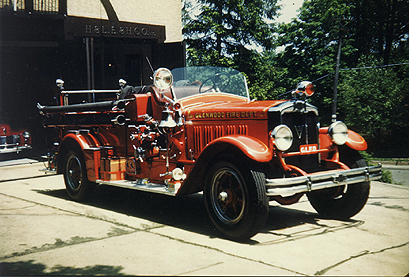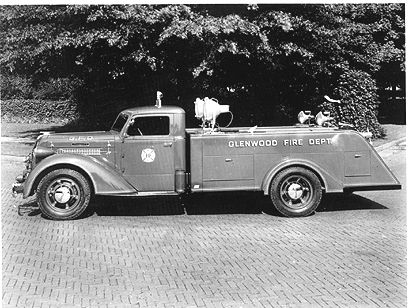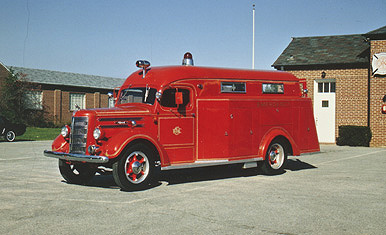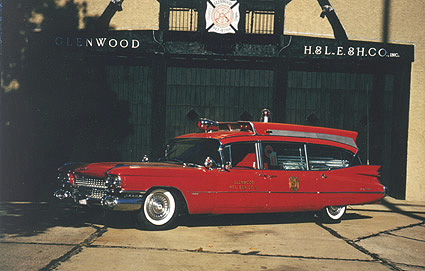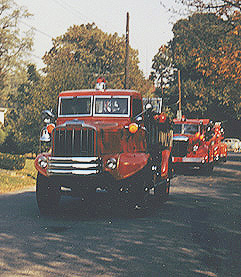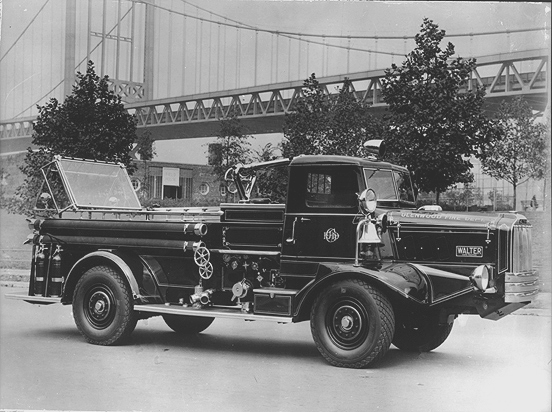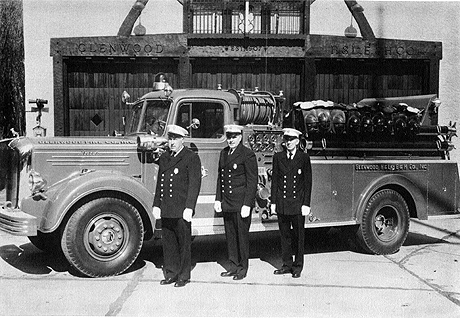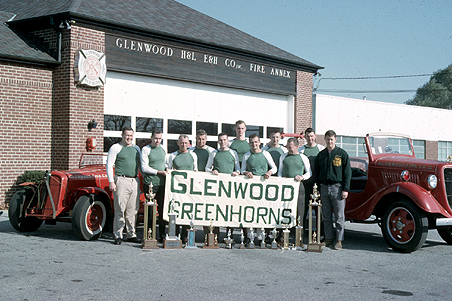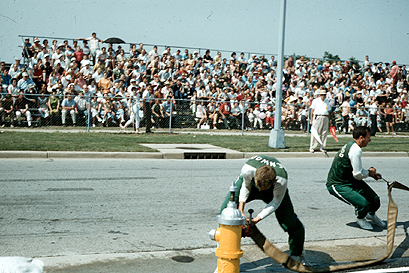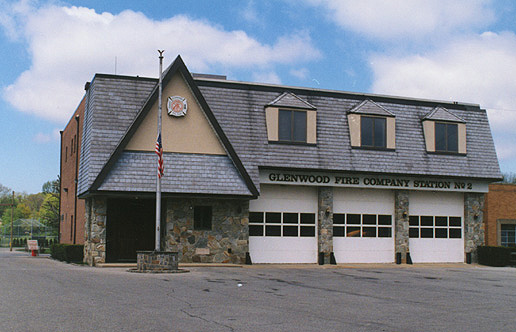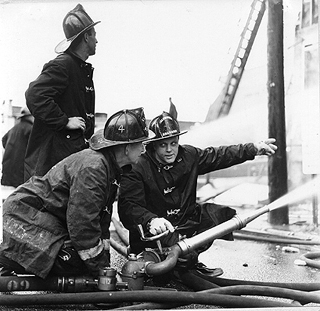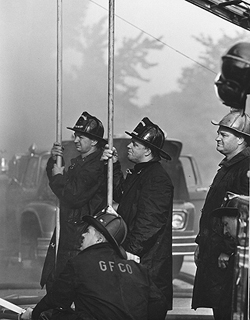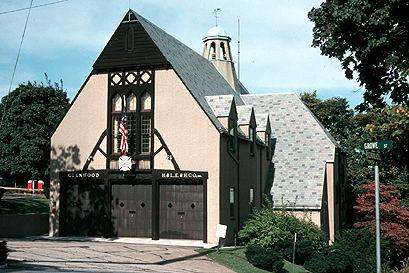
This is an unofficial page and is an historic look back at the Glenwood Fire Company
This page is still under construction
Last Update 03/09/2003
On April 18, 1907, eighteen men met at the chapel of the Glenwood Landing Church, for the purpose of forming a Fire Department. Those present were: Oscar Hendrickson, George Salter, Thomas Salter, Fred Moore, John O'Neil, Timothy O'Neil, Clifton H. Van Cott, Royal Latourette, Henry Latourette, Edward Bedell, James Fyfe, Ernest Hittorff, Oscar Wiggins, Alfred Tappan, Fred Mathewman, Arthur Olson, Charles Olson. After a long and serious discussion, five trustees were elected as a committee to raise money by subscription for the equipment of a Fire Department.
On May 2, 1907, an application for a charter was signed by the following men,as charter members of the newly born Glenwood Landing Hook and Ladder Engine and Hose Co. Fred Moore, Edward Bedell, Oscar D.Hendrickson, Henry Latourette, Edward S.Kinkaide, George Salter, Thomas H.Salter, Roy E.Latourette, Fred Mathewman, Timothy O'Neil, John J.O'Neil, William Smith, Oscar J.Wiggins, Ernest F.Hittorff and James Fyfe.
On May 23, Ernest Hittorff was elected the first Foreman, or Chief, of the newly organized Company. By June 20th, the sum of $161.00 had been collected and the trustees were empowered to purchase equipment. It is interesting to note that it was customary to collect 10 cents per member each meeting to pay for kerosene oil for the lamps. Caps and badges were purchased in August, 1907, and a "Fire Engine" was ordered. 25c dues per month was collected from each member. The charter was officially recorded in August, 1907, and the Glenwood Hook & Ladder Engine & Hose Co. was officially born.
In July, 1907 George Latourette was elected to membership; in September Will Seaman and Harry Tappen. Judge Townsend Scudder gave much time as legal counsel for the Company and was rewarded by being made the first honorary member.
The old schoolhouse, located on the present site of the Fire House, became the first Fire House, and the first apparatus consisted of a horse-drawn Hook and Ladder and two hose-carts drawn by the firemen. In March, 1913 electric lights were first provided for the Fire House. An old bell was the first fire signal, but later a steam whistle at the Nassau Light & Power Co. (now Long Island Lighting Co.) was used for fire signals. This whistle was also used by Sea Cliff with a different signal. Members were assessed 50 cents in 1913 for flowers and gloves to be worn at funerals. The first firemen's funeral attended was that of Valentine Smith, in 1914. In April, 1913, a dance for the benefit of the Company produced $6.80 in admissions-$6.20 in expenses and 60 cents profit for the Company.
In June, 1915 a fire district, consisting of Glenwood Landing and Glen Head across the L.I.R.R. tracks, was petitioned for and formed. In 1916 an amount of $300.00 was levied by tax, in each town of Oyster Bay and North Hempstead for the Fire Department. However, the Company was forced to resort to legal action to collect it and several years elapsed before it was settled. Also in 1916, it was voted to enlarge the little schoolhouse used as a Fire House, and $3,000.00 was raised by the sale of $10.00 bonds for this purpose. The property title was also cleared and it was noted that the Fire Department property now consisted of about 30 perches of land. The by-laws were changed in 1916 and the first Chief, instead of Foreman, was elected - Harry Tappen. A band was also started in 1916 with the proceeds of a minstrel show. Thus 1916 became a banner year for Glenwood's new Fire Department.
In 1917 and 1918, the years of World War 1, a Home Defense League was formed by the Fire Company to help in maintaining the home front. The flagpole, was presented by James Fyfe, and dedicated in April, 1918. It was a mast from a large sailing ship which raced in the International Yacht races. Note: a feather duster was also purchased in August, 1918. The first (new) truck was purchased in March, 1919, a Ford chassis for the sum of $593.00. The previous truck, a Stevens-Duryea had been purchased as a "used" truck.
In March, 1928 it was voted to dispose of the old Fire House and to build a new one on the same site. During the construction, a temporary fire house was built and used on the Stern Farm. In June, 1928 a ground breaking ceremony was held with Mr. Benjamin Stern of Stern Brothers, New York, as honored guest. Without his counsel and great financial assistance, the present Fire House would never have been built. He provided architects-Cherry & Matz-to design the House, and gave a substantial sum of money for the building. He was elected an honorary member of the Fire Company.
A year later, on January 26, 1929, the new Fire House was opened and dedicated with a parade and ceremonies by the local Company and visiting companies. The president of the Company, Peter A. Hesse, who had served for two years and had been a leader in the construction of the new house, passed away suddenly on January 9, 1929. Mr. Joseph Dioguardi, a trustee, was elected and installed in February, as President. 0scar J. Wiggins was Chief during this period.
During the Depression, 1929-1934, The Fire Company gave generously of its funds and many members served on the local relief committees.
During the war years 1941-1947, a large number of our young firemen were in the service of our country. The Company kept in touch with them by monthly letter and sent them a regular cash gift each month. Many beautiful souvenirs and interesting letters were sent to the Company by these service men. Since the Fire Company was a strategic part of the Civil Defense of Long Island, which was a critical defense area, the Fire Company members devoted many hours of volunteer service on watch in the Fire House. A 24 hour watch was instituted from Pearl Harbor Day to the Japanese surrender, conducted entirely by volunteers from the Company. The Fire Department has been, and still is, an integral part of our Nation's Civil Defense program.
Great disasters, violent storms and especially the hurricanes of 1938,1944 and 1952 have through the years kept the Fire Company members busy clearing roads, making rescues, pumping, preventing property damage, especially at the Long Island Lighting Plant, where the pumps worked continuously for several days to keep the water away from valuable turbines so as to preserve light and power for Long Island homes. An emergency crew was organized in 1932. These crews have developed over the years into a highly trained, efficient crew, which now responds to emergency calls 24 hours a day-every day of the year.
Hundreds of lives have been saved by the fine work of these unselfish crews.
In addition to the fire protection and emergency services provided by the Fire Company, other activities for the benefit of the community and its citizens have been given by the Company. The headquarters building has provided a meeting place for youth groups, such as Boy Scouts and Girl Scouts, for community and civic associations, for the Women's Club, for church and recreation groups. Movies, dances and children's Christmas parties have been sponsored and paid for by the Fire Company.
During the period from 1928-1940, the Fire Company held annual parades, fireworks and old-fashioned celebrations for the community, on the Glenwood School grounds.
The alarm system was tied in with the Civil Defense alarm and the Company members responded to all Civil Defense exercises. Training in "First Aid" had been an essential part of the training of all of The Fire Company firemen. Wood Gaylor organized the first "First Aid" crews and became the first Captain. Since that time, James Knight had carried on an extensive program of training in "First Aid", also serving as crew captain. James Knight also organized the first Blood Bank for firemen after the war. During the World War II and the Korean War, our men donated blood generously at regular intervals to the Red Cross Blood Bank.
Glenwood Landing's Fire Company has served the community for these many years, protecting the lives and property of our people. Today the Company stands as one of the best equipped and best trained units in the County, ready for any emergency whether it be fire, disaster, floods or other emergencies.
The members are all volunteers, resident citizens of our community, carefully selected and screened by a commmittee of members. It is considered a great honor to be elected to become a member of this Company. No man is a full-fledged member until he has served one full year of training as a probationary member and voted upon twice-once by the membership, once by the line officers. The Company now has a, strong Exempt Firemen's Association, which provides a small insurance and death benefit for its members. The funds for this purpose consist of money rebated by foreign insurance company premiums and membership dues.
We salute the members who gave unselfishly of their time and energy to
build up this efficient Company and trust that those who follow in their
footsteps will continue to render the same unselfish service.

This is the Glenwood Fire Company's main house located on the corner of
Grove street and School House Hill Road in Glenwood Landing L.I.. This picture
was taken by me on a visit in 1975.


There have been some changes to the main house since I took the shots in
1975. These pictures were taken by me although from different perspectives
while on a visit in May 1999 and shows the addition to the west side of the
building. I notice that the weather vane is missing from the top of the cupola
in these recent pictures. Most all the pictures on this page were taken by me
(except where noted) in 1965 during the time I was a member of this Department.
One of the requirements for continued membership was that you had to attend a
minimum number of calls, meetings and drills to stay on as an active member.
When I moved to Elmira Heights to work at the Ward LaFrance factory, I could no
longer keep up my active status, so I had to resign my membership. To my
regret, I neglected to join the exempt members association. I would love to
hear from any past or present members of the department. Email me at : geoley@covad.net



